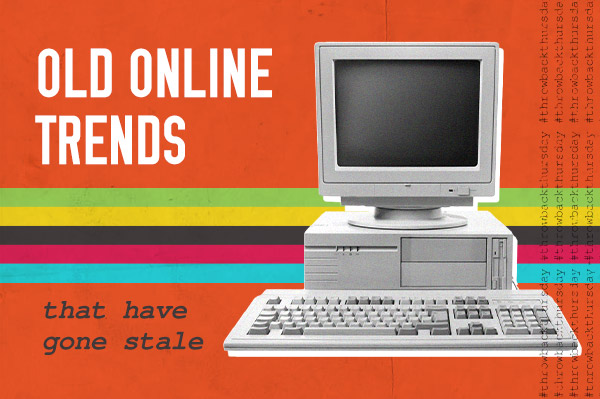If you work in any technology-based company or sector, you know things are always changing. What was standard practice and trendy and new one day or week becomes outdated and ineffective the next. As SEO trends constantly come and go, one simply can’t afford to not change. It is a company’s flexibility and ability to accept and support constant change that often succeeds.
If you’re interested in entering the technology field or you’re returning to the industry after a long break, here are some of the old online trends to avoid. You’ll notice these trends were once the accepted but have since grown stale and have fallen by the wayside:
Music Playing Website
As if hold music or elevator music wasn’t bearable, there was a time when companies welcomed visitors to their website with this awful, outdated music. This old online trend quickly became a no-no as website visitors quickly left a site.
“Click Here!” Linked Buttons
These forms of old online trends are still heavily used even though they aren’t as effective as other types of linked text. Web users now are in a hurry and want context to what kind of website a text link will take them to. The generic “click here” doesn’t tell the busy web user what the linked page is about and whether they would benefit by clicking through to it.
Long Sales Letters
There are multiple reasons the long sales letters disappeared. The largest two reasons being the fact that print is now largely out of date, being replaced with everything digitally, and the other being the short patience and attention spans of busy consumers who don’t want to read long text.
Buying Links
While a good link building campaign still has value today, the link building process has changed. The old online trend of buying links was common practice, but that technique of getting links is a serious no-no that violates SEO ethics and best practice today. Before buying links was a thing, anyone could link to whatever and however many of external pages as they liked. This caught the attention of Google, the largest search engine who put a stop to this form of link spamming with its Penguin algorithm. Since then it’s become important to consider where you’re linking to and the authority of that site.Linking to quality sites gains credibility for your site as well as the trust of Google and web users. Instead of buying links, it is acceptable to “trade” for links via guest posting and blogging outreach.
Yellow Page Advertising
Back in the day, the “Yellow Pages,” or phone book was delivered to each home. It contained a large, local business directory. If you needed a company’s phone number, hours, location or briefly see what they specialized in, you would look it up in the “Yellow Pages.” In addition to basic business information, some businesses would grab reader’s attention through sprinkling ads throughout the phone book. These old online trends was a good idea then. Now, however, with the widespread use and accessibility of the computer and Internet and smartphones, people now have immediate access to the same vital business information on the go.
Keyword Stuffing
In the past, SEO specialists and programmers were overzealous in their use of keywords. The use of keywords in a piece of content made it hard to read and understand. This caught the eye of Google who implemented the Panda algorithm to put a stop to the practice. The use of keywords in online content is still important today, but, now inserting an amount of keywords exceeding 3% of the content is looked down upon.
Artsy and Hard to Read Fonts
With all the websites out there, people use to use a variety of ridiculous fonts such as comic sans and papyrus to show the unique style and personality of the brand. However, these fonts were also distracting and
hard to read. Now, its more professional and credible to use an easy to read font such as a Times New Roman or Calibri and avoid the old online trend of overly artsy fonts.
Phony Stock Photos
While numerous organizations and companies still use stock photos on their websites and printed collateral, the stock photos of today are vastly better than their predecessors. The use of staged, grainy obviously noticeable stock photos are unpopular as these old online trends lower a brand’s credible perception.
Distracting Websites
Back in the day an overly busy website was seen as a way to impress the website visitor, make one’s website memorable in the sea of millions of other websites. Little did developers know how distracting and confusing these old online trends made their website. Today, developers are more focused on the user’s experience. This has resulted in an easy-to navigate, simplistic, yet creative looking websites.
Print Media
Print media has seen a similar to the demise of the “Yellow Pages” and phone book advertising. While print media is till widely used in advertising and in journalism, many consumers access information online via the internet on their smartphones. With the popularity of online media, many advertisers and news outlets have developed digital copies of their content.
Whether you’re an “old school” SEOer who has resisted changing with the times or you’re a new SEO specialist, avoid these common old online trends. They will keep you living in the “dark ages” and prevent you from seeing results in your company’s SEO strategies and campaigns.
If you’re a business owner and aren’t familiar with SEO and its current best practices, contact the specialists at SEO.com. We are a full-service internet marketing firm helping businesses both large and small with all aspects of their online presence. Our staff has been in the industry for numerous years and know the current SEO online trends. Contact us today to learn how we can help update your SEO strategy to be in alignment with current online trends.





